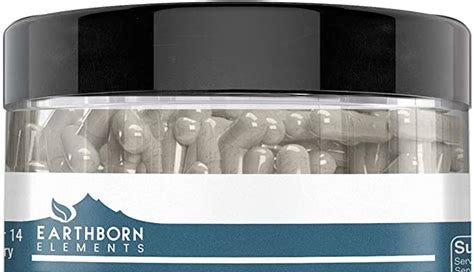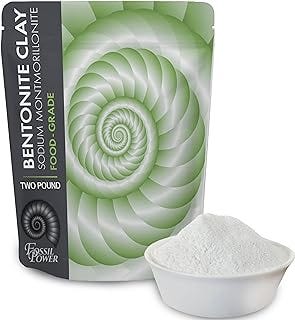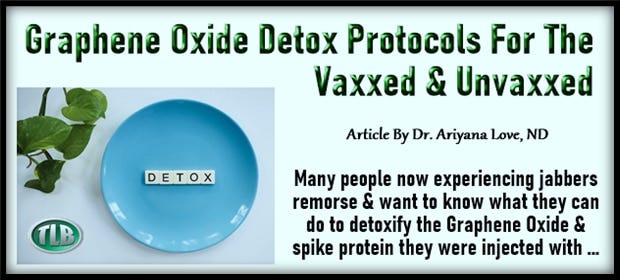Bendonite Clay for the Removal of Graphene from the Body
BC essentially “seeks” toxins in the body to bind with due to its chemical composition. Then it acts like a magnet and sponge, absorbing harmful substances so they can be removed from the body.
by: PubMed Bentonite Clay as a Natural Remedy: A Brief Review
The effect of bentonite on body function Detoxification
Bentonite clay has been shown to act as a detoxifying agent. This property is referred to its poly-cationic nature, which leads to absorption of negative charge toxins (7).
T-2 is a trichothecene mycotoxin which is a naturally occurring mold byproduct of Fusarium fungus and is toxic to humans and animals. When rats ingested bentonite for 2 weeks before T-2 toxicosis, a significant increase in fecal excretion of this toxin and a decrement of that in muscle has been reported (8) which indicates the healing effect of bentonite against T2 toxicosis.
Aflatoxins are poisonous and cancer-causing chemicals that are produced by certain molds which primarily affects liver. Firstly in 1989 Dvorak et al reported that bentonite is able to reduce water aflatoxin to 66% of its primary concentration which showed the adsorbing capacity of bentonite for aflatoxin (9). Schell et al showed that in pigs, when clay is added to aflatoxin-contaminated corn, it partially restored liver function without greatly affecting mineral metabolism (10). In rabbits fed with aflatoxin-contaminated diet, there is a deficiency in reproductive function and adding bentonite to the aflatoxin-contaminated diet improved the physical semen characteristics of buck and reproductive performance traits of doe rabbits (11). There are numerous animal feeding studies, which demonstrated that bentonites, can bind aflatoxins in ingested feed and reduce or eliminate the toxicity (12–15). Bentonite reduces the bioavailability of aflatoxin (16) and decreases the amount of Aflatoxin M1, which is a hydroxylated metabolite of aflatoxin B1 in Ghanaian population (17). Currently the safety of dietary bentonite is shown in different studies including animals and humans (2, 4–6). Besides, it does not affect the serum concentrations of important vitamins and nutrient minerals in humans (3). Then bentonite is being used in humans as a dietary intervention to prevent and cure aflatoxin toxicity.
Organochlorine pesticides are known to be one of the most persistent organic pollutants present in the environment. They are highly toxic, chemically and biologically stable and have the tendency to accumulate in organisms. Bentonite is reported to have the capacity to absorb pesticides due to its cationic nature (18). It has the potential for sorption the pesticide endrin possibly due to a combination of hydrophobic and charge-dipole interactions (19) in lab conditions. Paraquat is an herbicide, which is highly toxic to mammals, including human. Following ingestion of paraquat in high dose, hepatic, cardiac or renal failure or death might occur. In smaller doses the symptoms like as respiratory distress, renal dysfunction or, occasionally, jaundice or adrenal cortical necrosis appear. Gastric lavage with bentonite removes paraquet. It might acts as an adsorbent to reduce the effect of this toxin on body (20, 21). Then it might be concluded that bentonite counteract pesticides and herbicides toxicity.
Some toxins might exist in foods of livestock. Lantana camara, a species of flowering plant, is known to be toxic to livestock such as cattle, sheep, horses, dogs and goats. When cows which were poisoned with Lantana camara, were treated 5 days after with oral bentonite, five of 6 calves given bentonite recovered while 5 of 6 calves in the control group died and comparing with activated charcoal, the plasma total bilirubin concentration was statistically more appropriate in bentonite treated cows (22). Then bentonite is suggested to act as a cheaper and more effective treatment comparing with charcol.
Metal toxicity or metal poisoning is the toxic effect of certain metals in certain forms and doses on life. Lead poisoning is a medical condition in humans and other vertebrates caused by increased levels of the heavy metal lead in the body. Lead interferes with a variety of body processes and is toxic to many organs and tissues including the heart, bones, intestines, kidneys, and reproductive and nervous systems. In pigs, the feeding supplementation of montmorillonite for 100 days, reduced lead concentration in blood, brain, liver, bone, kidney and hair (23). Copper toxicity, also called copperiedus, refers to the consequences of an excess of copper in the body. Consistently in sheep, it was concluded the dietary Cu bioavailability could be decreased by oral supplements of bentonite (24). Cadmium is an extremely toxic metal commonly found in industrial workplaces. The exposure of carp (Carassius auratus to dietary cadmium caused oxidative stress, while montmorillonite supplemented in diet reversed relatively cadmium-induced oxidative damage in liver and kidney (25). Bentonite is additionally reported to decrease cadmium induced cytotoxicity and genotoxicity in Nile tilapia fish (26). Generally, it seems that bentonite is a reliable treatment for metal poisoning.
Generally, it seems that bentonite can be considered as a treatment in different types of toxicities although in some sorts of toxicities such as locoweed toxicosis in rats, it is not effective in alleviating the symptoms (27).
Article by Dr. Axe: Bentonite clay - How It Works
While bentonite clay has been used for centuries around the world to promote better health and ward off diseases, those living in the U.S. and Europe have, for the most part, only recently become familiar with this product.
What is bentonite clay used for? Bentonite clay (BC), also called calcium bentonite clay or Montmorillonite clay, is now taking off as a wellness trend among people who are looking to help naturally improve their skin’s health, detoxify their bodies and improve digestion.
Individuals in various cultures refer to BC as “healing clay,” since it cleanses various parts of the body. It’s possible to enjoy bentonite clay benefits by taking it internally (in other words, drinking and eating it), on top of using it externally on your skin and hair.
What Is Bentonite Clay?
Technically BC is an absorbent aluminium phyllosilicate clay. The largest known source of BC is found in Fort Benton, Mont., where numerous volcanoes are present.
What are the benefits of bentonite clay? As explained more below, these include:
Helping treat skin conditions
Aiding in detoxification processes
Protecting against bacterial infections
Supporting digestive and respiratory processes
Aiding in dental health
Supplying nutrients
Potentially helping with weight loss and more
How It Works
Bentonite clay benefits your body in several key ways:
It helps expel toxins and heavy metals.
It has antibacterial properties and fights off various pathogens responsible for disease, such as E. coli and the virus that causes staph infection.
It contains a range of nutrients. Bentonite clay is known to have an abundance of minerals, including calcium, magnesium, silica, sodium, copper, iron and potassium.
It nourishes skin/hair by balancing oil production, removing dead skin cells, clearing clogged pores and fighting bacteria.
BC can help reduce the negative effects of toxins that we encounter every day, such as those given off from paint, cleaning supplies, markers, substances used in building homes, low-quality unpurified water and even pesticides.
BC essentially “seeks” toxins in the body to bind with due to its chemical composition. Then it acts like a magnet and sponge, absorbing harmful substances so they can be removed from the body.
While in its natural state, bentonite clay has negatively charged molecules. Most toxins and heavy metals have positively charged molecules. This allows the two to bind together easily and stay united while the toxin removal process happens.
“Heavy metal toxins” usually refer to substances like mercury, cadmium, lead and benzene. Upon binding, BC is able to help remove metals, toxins, chemicals and impurities from the gut, skin and mouth. Additionally, it’s used to reduce the presence of toxins in the food supply and animal feed.
Some people also choose to use BC as a supplement, since the clay is a natural source of important dietary nutrients. When ingested into the body, either in a drink form or by eating the clay, its vitamins and minerals are absorbed similarly to supplements.
Top 12 Benefits and Uses
1. Supports Skin Health (Treating Oiliness, Poison Ivy, Dermatitis and Wounds)
Benefits of bentonite clay for skin include: When combined with water and left to dry on the skin as a clay mask, BC is able to bind to bacteria and toxins. It can help remove these substances from the surface of the skin and within pores, helping reduce breakouts.
Thanks to the clay’s special ability to act as an antibiotic treatment when applied topically, BC can also help calm skin infections, like diaper rash and contact dermatitis.
Topical application of bentonite clay has even been shown to help treat Buruli ulcers, a “flesh-eating” infection resulting from Mycobacterium ulcerans bacteria generally seen in third-world countries.
4. Helps with Thyroid Function
In mice studies, BC has been found to absorb certain thyroid hormones (T3 and T4), resulting in the alleviation of hyperthyroidism. This result suggests bentonite might potentially help people keep thyroid levels down, although the test has not been duplicated in humans as of yet.
5. Stops Growth of Two Cancer Cell Lines in a Lab
A lab study conducted in 2016 discovered that bentonite clay stopped the growth of cancer cell line U251, a human cancer cell found in a central nervous cancer called glioblastoma. However, another cell line was grown larger when exposed to the substance.
The researchers explained that the cell formations and swelling of bentonite clay are the reasons for this, and it could potentially be effective against specific types of cancers (like glioblastomas) but not others.
Another lab experiment observed bentonite clay caused cell death of Caco-2 cells, a colorectal cancer line. In this study, the clay exhibited a large amount of oxidative stress upon just the cancer cells without damaging the DNA.
6. Boosts Immunity by Killing Harmful Bacteria and Viruses
BC has been found to be effective at killing harmful bacteria. In a study published by the Journal of Antimicrobial Chemotherapy, “results indicate that specific mineral products have intrinsic, heat-stable antibacterial properties, which could provide an inexpensive treatment against numerous human bacterial infections.”
More research is still needed on the topic, but results of studies so far appear to be promising in terms of how the clay can be used as a treatment for these gut-related illnesses. On top of killing these types of infections and viruses, bentonite clay benefits your immune system by keeping the gut wall strong.
Much of the immune system actually lives inside of the gut microbiome, and when the gut wall is compromised, toxins are better able to leach into the bloodstream and cause serious problems. By protecting the gut wall and decreasing the amount of pesticides, toxins, bacteria and chemicals that could potentially enter the blood, the body is better able to protect itself.
7. May Support Respiratory Health
One type of virus that, at least in a lab, meets its match in bentonite clay is human adenovirus. While these viruses are not generally lethal, they do cause respiratory infections that can be particularly dangerous to infants or those with compromised immune systems.
No currently accepted treatment method exists for these viral infections, but it’s possible bentonite clay could be a candidate for more research on the subject.
Bentonite clay is also likely able to successfully treat paraquat poisoning in humans.
Paraquat is a toxic herbicide and is not available easily in the U.S. However, if it is ingested or breathed in, it can cause many a disease called Paraquat lung.
Like Fuller’s earth, some research shows that bentonite seems to be a potentially powerful agent against the damage paraquat can cause.
When should you take BC?
For the best results, do not not take bentonite within an hour of food. Also avoid taking it within two hours of medications or supplements, since it can interact with other substances.
Consuming bentonite clay drinks and capsules
If you plan on consuming bentonite clay by mouth (ingesting it either by eating or drinking the clay), try this: Drink 1/2 to 1 teaspoon once per day as many days of the week as you’d like. Mix the clay with water, preferably in a jar with a lid where you can shake the clay and make it dissolve. Then drink it right away.
Make sure to only ingest bentonite clay that’s food grade.
You can also look for BC capsules sold in supplement/health food stores. Be sure to follow instructions carefully.
FOSSIL POWDER Bentonite Clay Food Grade Powder - Pure & Natural for Toothpaste, Detox, and More - Heal Damaged Skin - DIY Clay Face Treatment (Amazon.com)
By: Dr. Ariana Love Graphene Oxide Detox Protocols For The Vaxxed & Unvaxxed
Investigative Journalist Ramola D., has additional recommendations for detoxifying Graphene Oxide (GO) Nanoparticles after exposure from chemtrails, here. Dr. Carrie Madej suggests regular detox baths with…
👉Bentonite Clay to help your body remove Graphene Oxide Nanoparticles.
Bentonite Clay at Herbco.com








Always enjoy learning about new things. Thank you